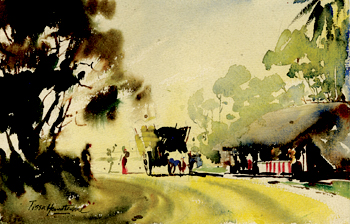Water colour paintings respond to shifting moods of nature
Tissa Hewavitarane
PAINTING: Water based media are among man's oldest painting
substances, dating back to the cave walls of Altamira, Lascaux and the
Sahara. Egyptian scribes diluted colour in water, added a binder and
tinted their wall illustrations. Medieval manuscripts were given life
with passages of water soluble colour.
|

Misty Morning: Lasting freshness |
Roman and Byzantine artists produced tempera by adding egg to their
mixtures, and painted on wooden panels. But the greatest contributions
to the transparent medium came from the Orient. As early as the 8th
century A.D. water colour painting was first started by the Chinese.
Today water colour painting has become a very popular medium in art.
To begin with there's the sheer pleasure of physically handling such a
fluid and responsive medium.
There is something calming and therapeutic about watching your brush
glide across the surface of the drawing paper like a skater on ice,
leaving behind it a drift of colour that glistens momentarily, then
settles into the fibres of the drawing paper and dries with a luminous
inner light.
Just as a short poem can say more than a thousand words, a good water
colour is capable of capturing all glories of nature, of light and sun
and air and mist, with just a few strokes of the brush. It is the unique
freshness and immediacy of water colour that appeals to the artist and
viewer alike.
More the merrier
British and European masters like Constable, Turner, Klee, Russel
Fline, and Picasso and the American Homer, Wiyeth and Hopper brought the
water-colour medium to the West. Water colour can be painted in any
country under any climate and by anybody. The more one paints more the
merrier.
Painting in water colour requires a high degree of planning
forethought and patience. With an opaque medium such as oils, you can
build up the paint in layers, applying light colours over dark ones and
obliterating mistakes by painting over them.
But, water colours are transparent you can't paint light colour over
dark one as the darker colour will show through. This means that you
have to know in advance which areas of the picture are going to be light
and which are going to be dark, and be prepared to work methodically
from 'light to dark', cutting around those areas which you want to leave
as bare paper.
If you don't plan things carefully, you may lose control of the
painting.
The painting I have depicted with this article is a 'misty morning'.
It's a village scene supported by a composition of other characters, a
tea boutique, bullock cart, people with trees on either side which gives
balance and unity to the painting.
The main idea is to capture the mist in the early morning which
carries the main theme of the painting. The wayside boutique and the
cart give a good composition using lightest and darkest tones which a
viewer's eye is always attracted by a strong contrast, and forms a focal
point of the picture.
Centre of interest
Also note the sweeping curve of the road that leads us to the centre
of interest, instead of veering out of the picture. In this painting,
the use of strong contrast of light and dark tones are applied on top of
the other to build up depth of tone and colour to make the painting more
exciting and dynamic.
Light is one of the most important part of a painting. The main focus
is on light and how it affects the painting in colour, its effects on
the atmosphere and the pictorial space. Without this one element in the
painting, there is nothing. One who happens to express himself in the
medium of water colour has to know before he begins and before the brush
stroke touches the paper.
Difficult medium
The water colourist cannot guess, and while, he may make minor
corrections, that is all. He works by elimination, by paring a subject
down to its essentials. Water colour, therefore, is the ideal medium for
capturing the effects of light and is a medium that is fresh, alive and
responsive to the moment and the shifting moods of nature.
Water colour painting is said to be a difficult medium in art,
because is said to be a cover up your mistakes as you can oil painting.
Water colour painting, like other arts needs practice. The more one
practises, the better artist one becomes.
My advice to a beginner is that you should never give or get
depressed if you paint a bad picture. If you want to become a successful
painter, never ever give up. First class water colour painters make
mistakes, but they try and try again, and only then do they succeed.
By relentless hard work and constant practice one will become a
master of this medium. One of the greatest attractions of a good water
colour painting is its lasting freshness for many years after it has
been painted, provided it is carefully preserved by good framing.
The writer is an internationally known artist who has held many
exhibitions here and abroad. His main medium is water-colours. |

